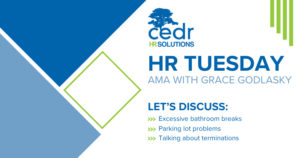Setting the Stage: Doing What Matters With Purpose

Hello AADOM tribe! Welcome to the second part of our HR Crash Course that we developed specifically for you based on the questions you all asked us at the AADOM conference in Scottsdale. It’s the holiday season! Do you know what the holidays (and pretty much all other months of the year…) make us here at CEDR think about? Hiring.
In the last installment of this course, we talked about the beginning stages of hiring: inward thinking, creating the right job descriptions and ads, and setting up initial interviews. If you missed it, be sure to go back and read that first.
For this edition, these were the questions that you asked us to give guidance on:
- Can you do an onboarding new hire checklist that includes what is required to have based on the employee handbook?
- When I set someone up for a working interview, are there certain guidelines around what I can have them do?
- In this current employment climate, which is very employee friendly and they have a lot of prospects, how can I best offer the job to get them to work for us?
Hiring with purpose is the main mantra we want you to keep in mind here. This process sets the stage for not only you and makes you more prepared but for your interviewee as well. You want your candidate to get a preview of your company culture, so they can be just as sure as you are that this job is the right fit for them.
Test Those Skills
When the interview process goes well, you might start thinking about how to gauge a candidate’s ability to perform on the job, which might lead you to consider setting up a “working interviewOpens in a new tab to CEDR’s website”. However, we all know those are not legal (click the link to see why!) and much prefer doing a skills test. “Skills tests” are beneficial when evaluating candidates for clinical positions. By testing your applicants’ abilities and knowledge without having them perform actual work for your business, you can get an idea of their skill level without putting your practice at risk.
For example skills tests you can use to test applicants at your business, download our free Working Interviews Guide, Make Working Interviews WorkOpens in a new tab to download the guide.
Having a skills test with the purpose of telegraphing your culture, along with our high standards, to them while they demonstrate their knowledge to you is a vital component of seeing if this candidate will, in fact, be a difference maker for you. The skills test will enlighten you about their abilities and give them a glimpse of your company in real-time. They will be able to experience the environment, the other people working that day, and so on.
Offer That Job
Your candidate has soared through the interview and skills testing process with flying colors, and now you’re ready to invite them to join your team. They have been asked when they are ready to start and if they still want the job, and everything is aligning! It’s time to extend the offer.
The first thing you will want to do is prepare a formal offer letter. Presenting an offer letter is an essential step because it ensures that you and the candidate are on the same page regarding the expectations of their position. In many states, employers are required to clearly state the rate of pay, method of pay, and other criteria to employees upon hire, so this document can also help satisfy legal requirements.
Additionally, the offer letter helps to eliminate any unnecessary confusion or disagreement about the position offered by putting the relevant details in writing. You may also want to add a list of the benefits being provided to the candidate as part of their employment in your offer letter, or you could indicate that benefits are outlined in your employee handbook and offer to answer any questions that remain.
Prepare to have your heart broken…
One of the main things we want you all to keep in mind here is when you know you have your ideal candidate, you want to make an offer and make it quickOpens in a new tab to CEDR’s website. We all know how difficult it can be to find a good potential employee, but you must remember that they are actively searching for employment (and most likely, interviewing for more practices than just yours!). Showing the candidate that you are moving this process along as quickly as you can shows them that you not only are interested in hiring them but respect their time. Remember, you’re hiring with a purpose here. Part of that purpose is establishing your company culture with the candidate right from the beginning, and respecting people’s time is an integral part of a solid culture. And, even with all that, your number one candidate may decline.
*Que trombone sound.*
But keep the faith because, in the Hiring GuideOpens in a new tab to download the guide, we explain that your 2nd and 3rd candidates are probably hanging out there, and you will need to shift to them and make an offer quickly. By the way, we often see first-choice candidates come back two weeks later because the other position they took is not working out! Tough luck first choice candidate, maybe next time.
Check That Background
Background checks are a great way to ensure the safety of your clientele and team members and to prevent unwanted liability or surprises down the road. For example, a background check can prevent hiring a candidate with a criminal history of embezzlement or fraud and can help you avoid claims of negligent hiring if someone has a serious criminal history that could potentially put patients or employees at risk of harm. We can share that at least two or three times per month, we get calls for help with situations where background checks were not performed, and people with serious criminal records have been hired.
If you extend an offer and it is accepted, you can and absolutely should work with a reputable background check provider to issue the required consent forms and run your background check. At CEDR, we work with an organization called National Crime SearchOpens in a new tab to CEDR’s website, and we typically suggest that all of our members use them to run checks on every employee they invite to join their teams.
Your background check results may come in after your new employee has started working, but this is why your offer letter should indicate that continued employment is contingent upon the successful completion of the background check.
Be consistent and objective with your background check process to avoid potential discrimination claims. You shouldn’t run a background check for one hygienist you hire and not run a check for another part-time new hygienist who is good friends with your accountant, for example.
If the results from a background check make you want to rescind your offer of employment, state law may require you to provide a copy of the background check results to the candidate and offer them a chance to dispute the findings.
Onboard That Employee
By now, you’ve already sent your job ad out into the world, held interviews and conducted skills tests, selected a candidate, made a formal offer of employment, and begun running a background check on your new employee.
But the hiring process isn’t over quite yet! The goal is not only to bring that new employee into the fold of your business but to set them up for success and increase their chances of staying with your business for the long haul. This is where an organized and effective onboarding process comes into playOpens in a new tab to CEDR’s website.
You’ll want to prepare for each new employee’s onboarding experience before that employee shows up to work. Make sure you’ve got a new hire checklist ready that outlines all of the required forms and information you’ll need to collect upon hireOpens in a new tab to download the checklist, such as an I-9 form and tax withholding forms, as well as any state-required notices you’ll need to provide.
You’ll have to also re-deliver their job description along with the offer letter and a copy of your employee handbook. You can accomplish all of these items through the HR VaultOpens in a new tab and HIPAA training software provided via your AADOM membership courtesy of CEDR.
Don’t forget to hold a physical orientation as part of your onboarding process–send your new hire a message before their first day that goes over how to access the building, where to park, and how to raise any questions that might come up. Give your new employee a tour on their first day of work, and consider identifying a “mentor” that can help introduce them to the rest of the team.
Try your best to make the onboarding process fun! Provide new employees with a goodie bag full of company-branded swag on day one. Take them to lunch with the team and consider having team members record welcome messages to the new hire. Anything you can do to make your new hire feel welcome will help them reaffirm their decision to join your team.
Remember that the prevailing thinking about onboarding is that while most of the initial onboarding stuff is accomplished within the first few weeks, onboarding and check-ins should go on for as long as the entire first year.
Stay Tuned…
Join us next month for our third installment of CEDR’s “HR Manager Crash Course.” Next, we are going more in-depth about company culture and how a team with as few as two or three people can benefit from the principles behind building solid cultures for your practice.





